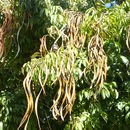en
names in breadcrumbs


Markhamia lutea, the Nile tulip, Nile trumpet or siala tree is a tree species of the family Bignoniaceae,[2] native to eastern Africa and cultivated for its large bright yellow flowers. It is related to the African tulip tree. Native to Africa, Markhamia was named in the honour of Clements Markham (1830-1916), who worked in India. An evergreen small tree that grows to 4–5 m in height outside of native zones, although it can reach more than 10 m in its zones of origin. Leaves, of 20–30 cm in length, normally arranged in groups in the ends of the branches. Flowers in terminal clusters. They are trumpet shaped, yellow in colour, with orange-reddish spots in the throat. They measure 5–6 cm in length. Fruit is a capsule, of up to 70 cm in length, with abundant winged seeds. It is propagated by seeds.
African Union (2010-03-02), List of Countries which have Signed, Ratified/Adhered (PDF), archived from the original (PDF) on 2012-09-02
Markhamia lutea, the Nile tulip, Nile trumpet or siala tree is a tree species of the family Bignoniaceae, native to eastern Africa and cultivated for its large bright yellow flowers. It is related to the African tulip tree. Native to Africa, Markhamia was named in the honour of Clements Markham (1830-1916), who worked in India. An evergreen small tree that grows to 4–5 m in height outside of native zones, although it can reach more than 10 m in its zones of origin. Leaves, of 20–30 cm in length, normally arranged in groups in the ends of the branches. Flowers in terminal clusters. They are trumpet shaped, yellow in colour, with orange-reddish spots in the throat. They measure 5–6 cm in length. Fruit is a capsule, of up to 70 cm in length, with abundant winged seeds. It is propagated by seeds.
La Markhamia lutea, nota anche come tulipano del Nilo, tromba del Nilo o albero siala, è una pianta della famiglia delle Bignoniaceae,[2] originaria dell'Africa orientale e coltivata per i suoi grandi fiori giallo brillante.
Originaria dell'Africa, è stata chiamata Markhamia in onore di Clements Markham (1830-1916).
È un piccolo albero sempreverde che cresce fino a superare i 10 m, e raggiunte i 5 m di altezza al di fuori delle zone native. Le foglie, di 20-30 cm di lunghezza, sono normalmente disposte a gruppi alle estremità dei rami.
I fiori sono a forma di tromba, di colore giallo con macchie rosso/arancio al centro, disposti in grappoli terminali.
La Markhamia lutea, nota anche come tulipano del Nilo, tromba del Nilo o albero siala, è una pianta della famiglia delle Bignoniaceae, originaria dell'Africa orientale e coltivata per i suoi grandi fiori giallo brillante.
Originaria dell'Africa, è stata chiamata Markhamia in onore di Clements Markham (1830-1916).
È un piccolo albero sempreverde che cresce fino a superare i 10 m, e raggiunte i 5 m di altezza al di fuori delle zone native. Le foglie, di 20-30 cm di lunghezza, sono normalmente disposte a gruppi alle estremità dei rami.
I fiori sono a forma di tromba, di colore giallo con macchie rosso/arancio al centro, disposti in grappoli terminali.
Markhamia lutea é uma espécie de árvore da família Bignoniaceae e nativa da África.[1] É encontrada na Etiópia, Quênia, Tanzânia, Uganda e Ruanda.
Markhamia lutea é uma espécie de árvore da família Bignoniaceae e nativa da África. É encontrada na Etiópia, Quênia, Tanzânia, Uganda e Ruanda.
Markhamia lutea là một loài thực vật có hoa trong họ Chùm ớt. Loài này được (Benth.) K.Schum. mô tả khoa học đầu tiên năm 1895.[1]
Markhamia lutea là một loài thực vật có hoa trong họ Chùm ớt. Loài này được (Benth.) K.Schum. mô tả khoa học đầu tiên năm 1895.